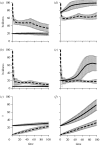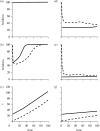Risk, resources and state-dependent adaptive behavioural syndromes
- PMID: 21078650
- PMCID: PMC2992746
- DOI: 10.1098/rstb.2010.0207
Risk, resources and state-dependent adaptive behavioural syndromes
Abstract
Many animals exhibit behavioural syndromes-consistent individual differences in behaviour across two or more contexts or situations. Here, we present adaptive, state-dependent mathematical models for analysing issues about behavioural syndromes. We find that asset protection (where individuals with more 'assets' tend be more cautious) and starvation avoidance, two state-dependent mechanisms, can explain short-term behavioural consistency, but not long-term stable behavioural types (BTs). These negative-feedback mechanisms tend to produce convergence in state and behaviour over time. In contrast, a positive-feedback mechanism, state-dependent safety (where individuals with higher energy reserves, size, condition or vigour are better at coping with predators), can explain stable differences in personality over the long term. The relative importance of negative- and positive-feedback mechanisms in governing behavioural consistency depends on environmental conditions (predation risk and resource availability). Behavioural syndromes emerge more readily in conditions of intermediate ecological favourability (e.g. medium risk and medium resources, or high risk and resources, or low risk and resources). Under these conditions, individuals with higher initial state maintain a tendency to be bolder than individuals that start with low initial state; i.e. later BT is determined by state during an early 'developmental window'. In contrast, when conditions are highly favourable (low risk, high resources) or highly unfavourable (high risk, low resources), individuals converge to be all relatively bold or all relatively cautious, respectively. In those circumstances, initial differences in BT are not maintained over the long term, and there is no early developmental window where initial state governs later BT. The exact range of ecological conditions favouring behavioural syndromes depends also on the strength of state-dependent safety.
Figures





Similar articles
-
An explanatory framework for adaptive personality differences.Philos Trans R Soc Lond B Biol Sci. 2010 Dec 27;365(1560):3959-68. doi: 10.1098/rstb.2010.0215. Philos Trans R Soc Lond B Biol Sci. 2010. PMID: 21078648 Free PMC article. Review.
-
Recent models for adaptive personality differences: a review.Philos Trans R Soc Lond B Biol Sci. 2010 Dec 27;365(1560):3947-58. doi: 10.1098/rstb.2010.0221. Philos Trans R Soc Lond B Biol Sci. 2010. PMID: 21078647 Free PMC article. Review.
-
Parasitism and the evolutionary ecology of animal personality.Philos Trans R Soc Lond B Biol Sci. 2010 Dec 27;365(1560):4077-88. doi: 10.1098/rstb.2010.0182. Philos Trans R Soc Lond B Biol Sci. 2010. PMID: 21078659 Free PMC article. Review.
-
The influence of environmental gradients on individual behaviour: Individual plasticity is consistent across risk and temperature gradients.J Anim Ecol. 2019 Apr;88(4):511-520. doi: 10.1111/1365-2656.12935. Epub 2019 Jan 23. J Anim Ecol. 2019. PMID: 30516829
-
Coping styles and behavioural flexibility: towards underlying mechanisms.Philos Trans R Soc Lond B Biol Sci. 2010 Dec 27;365(1560):4021-8. doi: 10.1098/rstb.2010.0217. Philos Trans R Soc Lond B Biol Sci. 2010. PMID: 21078654 Free PMC article. Review.
Cited by
-
Modelling the impact of condition-dependent responses and lipid-store availability on the consequences of disturbance in a cetacean.Conserv Physiol. 2022 Nov 17;10(1):coac069. doi: 10.1093/conphys/coac069. eCollection 2022. Conserv Physiol. 2022. PMID: 36415287 Free PMC article.
-
Roll with the fear: environment and state dependence of pill bug (Armadillidium vulgare) personalities.Naturwissenschaften. 2019 Feb 7;106(3-4):7. doi: 10.1007/s00114-019-1602-4. Naturwissenschaften. 2019. PMID: 30729319
-
Experimental evidence for adaptive personalities in a wild passerine bird.Proc Biol Sci. 2012 Dec 22;279(1749):4885-92. doi: 10.1098/rspb.2012.1936. Epub 2012 Oct 24. Proc Biol Sci. 2012. PMID: 23097506 Free PMC article.
-
Plasticity varies with boldness in a weakly-electric fish.Front Zool. 2016 Jun 6;13:22. doi: 10.1186/s12983-016-0154-0. eCollection 2016. Front Zool. 2016. PMID: 27274354 Free PMC article.
-
Within-individual correlations reveal link between a behavioral syndrome, condition and cortisol in free-ranging Belding's ground squirrels.Ethology. 2015 Feb;121(2):125-134. doi: 10.1111/eth.12320. Ethology. 2015. PMID: 25598565 Free PMC article.
References
-
- Alzaga V., Vicente J., Villanua D., Acevedo P., Casas F., Gortazar C.2008Body condition and parasite intensity correlates with escape capacity in Iberian hares (Lepus granatensis). Behav. Ecol. Sociobiol. 62, 769–77510.1007/s00265-007-0502-3 (doi:10.1007/s00265-007-0502-3) - DOI - DOI
-
- Arendt J. D.2009Influence of sprint speed and body size on predator avoidance in New Mexican spadefoot toads (Spea multiplicata). Oecologia 159, 455–46110.1007/s00442-008-1210-z (doi:10.1007/s00442-008-1210-z) - DOI - DOI - PubMed
-
- Basolo A. L.2008Evolution of pleiotropic alleles for maturation and size as a consequence of predation. Biol. Lett. 4, 200–20310.1098/rsbl.2007.0638 (doi:10.1098/rsbl.2007.0638) - DOI - DOI - PMC - PubMed
-
- Bell A. M.2005Differences between individuals and populations of threespined stickleback. J. Evol. Biol. 18, 464–47310.1111/j.1420-9101.2004.00817.x (doi:10.1111/j.1420-9101.2004.00817.x) - DOI - DOI - PubMed
-
- Bell A. M., Sih A.2007Exposure to predation generates personality in threespined sticklebacks. Ecol. Lett. 10, 828–83410.1111/j.1461-0248.2007.01081.x (doi:10.1111/j.1461-0248.2007.01081.x) - DOI - DOI - PubMed
Publication types
MeSH terms
LinkOut - more resources
Full Text Sources

